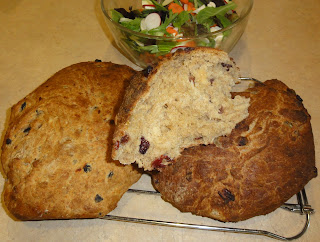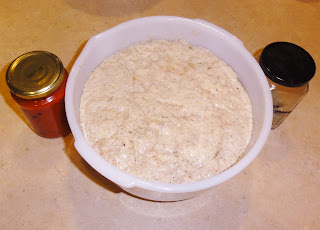The bread on the left is the Black Olive Bread; on the right (and the hot, torn chunk) is the Cranberry bread posted next)
This is a variation on the bread I made last week and posted earlier. It contains more whole wheat flour, a few different ingredients and a much longer rise.
This is a variation on the bread I made last week and posted earlier. It contains more whole wheat flour, a few different ingredients and a much longer rise.
I also varied the baking itself. In that recipe, I was using the closest pot I
had to a large heavy pot with a lid, which Lahey recommends in his book My
Bread. This time I made two
different loaves of bread (the other is listed in a separate post) and baked
them together on one preheated clay rectangular baking pan that I sprayed and
sprinkled with wheat flour. (I would
have used cornmeal, but I didn’t have any.)
Black Olive and Roasted Pepper Bread
Ingredients
½ tsp. yeast (Use yeast that is sold in a jar
and refrigerate it if you will make a lot of bread)
1 c. water
½ c. water from a jar of black olives (it
already contains some salt and oil)
¼ c. olive oil (because I wanted the flavor)
1 tbsp. honey or sugar (to boost the yeast)
1 ½ c. bread flour
1 ½ c.
whole wheat (I use malted, stoneground)
1 tbsp. garlic
1 tsp. somewhat crushed dry rosemary leaves
(crush them so the diners don’t have the sensation of gnawing on sticks)
1/3 c. chopped lightly pickled roasted red
bell peppers with the liquid squeezed out
1/3 c. sliced black olives
½ c. additional bread flour
Baking spray
Cornmeal for dusting
1 tbsp. butter, room temperature, mixed with
1 tbsp. olive oil for rubbing on top (don’t use just butter or it will scorch.)
Mix together yeast, water, olive water and
honey/sugar, preferably in a big electric mixer bowl. Add the flour,
olive oil, garlic, peppers, olives and rosemary a little at a time so as not to
make a big mess all over the kitchen. When the batter is mostly mixed –
and yes, it will resemble a thick, sticky batter - turn the mixer on higher and
beat it some more. Remove the dough hook, cover the bowl and leave the
dough to rise at least 12 hours, until doubled. I covered mine at 8pm and
put it in the refrigerator, came back to it at 8am, and put it back on the
counter until 10 am. Then I punched it
down and continued on.
When you come back to the dough, it should be
somewhat bubbly looking as well as doubled in size.
Punch down the dough, mix in 1/2 cup of bread
flour and knead the dough within the bowl. Shape it into a round and
recover it for a second rising. This is not the same as Lahey’s
instructions to move the dough to the board. This picture is from the
previous loaf, in which I waited to add the peppers until after moving the
dough because I was trying to keep the dough from sticking to the board. It stuck anyway. So I’m recommending
you save yourself some trouble and do it all in the bowl. Since the dough
will fall when you move it into the hot pot, it really doesn’t matter
where you punch it down and reshape it.
Let the dough rise until it has doubled in
bulk again. Assuming your house is around 70 degrees, this should be
about 2 hours total. About 1 ½ hours in, turn the oven on to 475 degrees,
spray your pan with cooking spray, dust it with cornmeal and put it into the
oven on the second to lowest rack.
When 2 hours are up, make sure the dough is
adequately risen. Remove the pan from the oven. As gently as
possible, slide the dough out of the bowl and onto the pan. Careful not
to burn yourself. Gently rub the butter/oil mixture on. Place gently back in the oven. The dough will fall! A lot!
But if you are gentle it will not fall completely and it will also rise
again in the first few minutes of shock of oven heat. Resist the urge to open the oven early. If you have left your loaf in a round, you
won’t need to. It will be dark, but not
unbearably so.
Bake the bread half an hour at 475 degrees,
then lower the temperature to 425 degrees and bake another 20 minutes. Remove the loaf from the oven and place it on
a rack to cool; do not slice or break it for 15 minutes. This untouched cooling period is very
important to improve the temperature.
Have you ever eaten a loaf that was mushy inside and dry outside? It was probably opened too soon. So resist worrying about it (because it looks
too dark) or lusting for it (because it smells so good) and go do something
else for 15 minutes. It’s too hot to eat
anyway!
Wait until it is thoroughly cool to wrap it
(that is, if you have any left over!) in wax paper or a waxed paper bag. Do not use plastic or your lovely, crunchy
crust will soften.


No comments:
Post a Comment